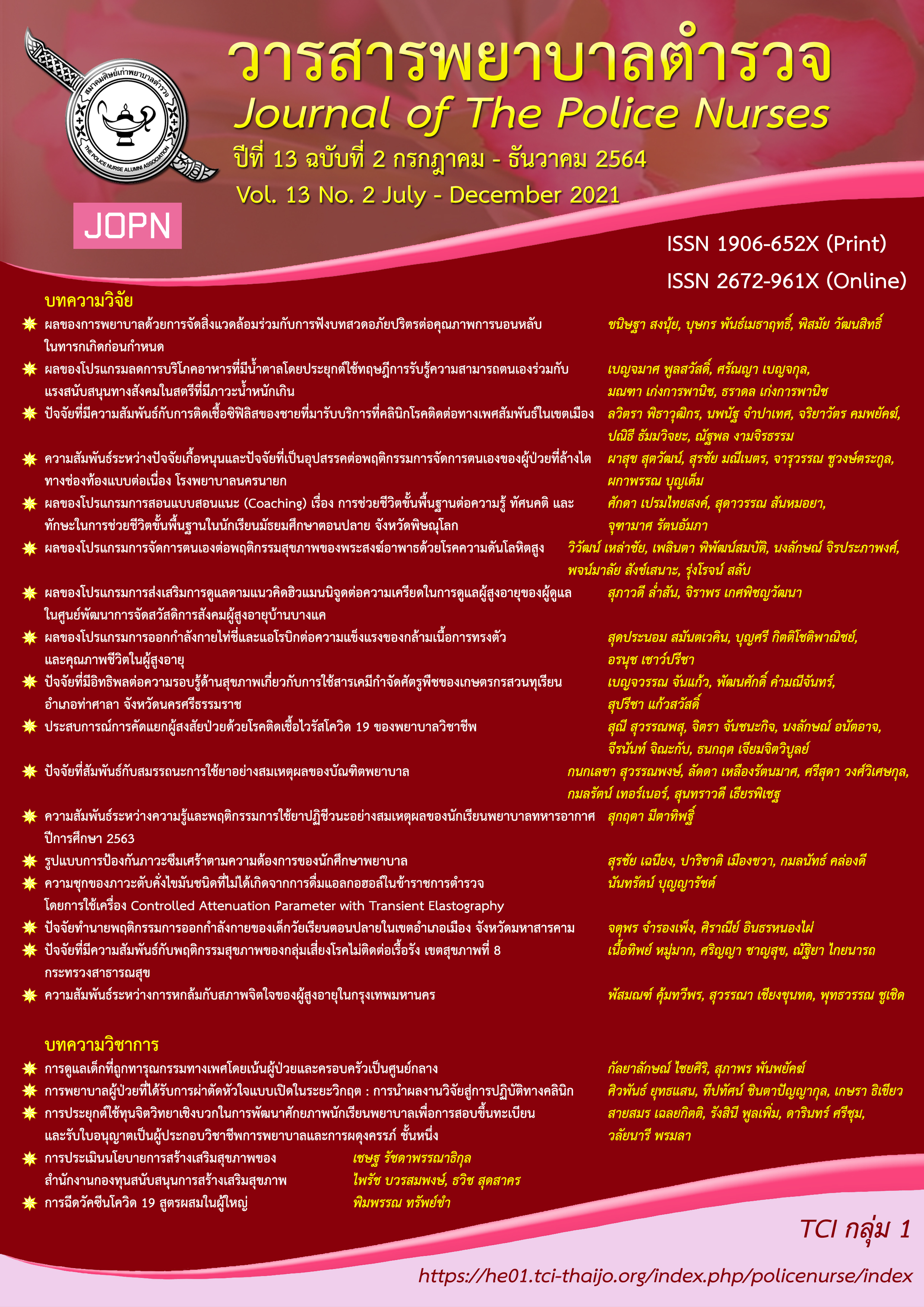PATIENT- AND FAMILY-CENTERED CARE FOR SEXUALLY ABUSED CHILDREN
Keywords:
children care, sexual abuse, patient-and family-centered careAbstract
Sexual abuse in children is continuously occurred at both domestic and international levels, affecting the victim in numerous aspects such as physique, mentality, family, and society. It is challenging for nurses to take care of these sexually abused children because they are sensitive and fragile. Thus, the accessibility to the responsive care of the victims and their families is crucial. This paper applied the concept of patient- and family-centered care to the treatment of sexually abused children, allowing related medical personnel, especially nurses, to be able to provide suitable care that satisfies the needs of the children and their families. Families are the source of trust, wholesomeness, and safety for children. Moreover, families can defend the right of their children and partially decide the most suitable care for them. They can also participate in the process of abused childcare from problem analysis, care planning, physical and mental nursing practice, reoccurred sexual abuse prevention, to the evaluation of care that has nurses as informants. These nurses can facilitate and support the families by considering the needs and benefits of the children and their families, assisting the sexually abused children to be able to face, decrease, and effectively prevent the short-term and long-term effects so these children can surpass this harsh period.
Downloads
References
Boon-yasidhi, V., Tarugsa, J., Manaboriboon, B., Chokephaibulkit, K., & Sathirareuangchai, S. (2014). A hospital-based clinical practice guideline for the management of child abuse. Thai Journal of Pediatric, 53(3), 160-172.
Butkatanyoo, A., & Muangkaew, P. (2019). The model for moving forward the adolescent health network in prevention and solution against adolescent pregnancy, Ban Laem district, Phetchaburi. Region 4-5 Medical Journal, 38(4), 264-276.
Choowichian, N. (2007). Effect of art therapy on the self-esteem of sexually abused adolescents (Master of nursing science program, mental health and psychiatric nursing). Faculty of Nursing, Chiang Mai University, Chiang Mai.
Corby, B. (2000). Child abuse: Towards a knowledge base. Berkshire: Open University Press.
Durongritichai, V. (2006). Family-center care nursing: Trends and challenging roles of nurses in family health care. HCU Journal, 9(1), 90-106.
Gould, F., Clarke, J., Heim, C., Harvey, P. D., Majer, M., & Nemeroff, C. B. (2010). The effects of child abuse and neglect on cognitive functioning in adulthood. Journal of Psychiatric Research, 46, 500-506.
Jengtee, S. (2013). Treatment of child abuse with act of child protection A.D. 2003. Journal of Healthand Nursing Research, 29(1), 149-157.
Kearney, C. A., Wechsler, A., Kaur, H., & Lemos-Miller, A. (2010). Posttraumatic stress disorder in maltreated youth: A review of contemporary research and thought. Clinical Child & Family Psychology Review, 13, 46-76.
Khaosod online. (2018). Police general hospitals take care of victims of sexual harassment revealing high statistics each year. Retrieved from https://www.khaosod.co.th/around-thailand/news_1237680
Know Violence in Childhood. (2017). Ending violence in childhood: Global Report 2017. New Delhi: Lopez Design.
Konle, T., Pongjaturawit, Y., & Phaktoop, M. (2010). Experience in sexual abuse among female adolescents. Journal of Nursing and Education, 3(2), 57-72.
Ministry of Social Development and Human Security. (2013). Assault statistics report: Bodies in children and women who can be serviced at the dependable center, Buddhist Era 2013. Bangkok: Ministry of Social Development and Human Security.
Musiksukont, S., Tilokskulcha, F., Lerthamtewe, W., Preungvate, O., Sangperm, P., & Payakkaraung, S. (2015). Textbook of pediatric nursing volume 1 (5th ed.). Bangkok: Mahidol university.
Namjantra, R. (2009). Patient-and family-centered care: A challenge model of healthcare services. Thai Journal of Nursing Council, 24(1), 5-10.
National Statistical Office and United Nations Children’s Fund. (2020). Thailand multiple indicator cluster survey 2019 survey findings report. Bangkok: Thailand National Statistical Office.
Neesyant, P. (2006). Case study child sexual abuse. Bangkok: Srinakharinwirot University.
Ngamsuoy, A., & Sonkongdang, W. (2020). Nursing children with health problems. Chiang Mai: Smart Coating and Services.
Obec student protection center (OBEC SPC). (2018). Student help and protection project. Retrieved from http://obecspc.com/download/
Police General Hospital One Stop Crisis Center. (2020). Guidelines for verifying people Sexually abused Police general hospital.
Royal Thai Government Gazette. (2003). Child protection act. A.D.2003. 1-29.
Sitdhiraksa, N., Wannasewok, K., Wannarit, K., Pukrittayakami, P., Apinuntavech, S., & Ketumarn, P. (2015). Siriraj psychiatry DSM-5 (2nd ed.). Bangkok: Department of Psychiatry Psychiatry, Faculty of Medicine Siriraj Hospital, Mahidol University.
Wiriyaprakob, R. (2011). Rights and liberty protection of injured persons in criminal case: A case study of sexual harassment (Master of arts in political science program, justice and social administration). Faculty of Political Science, Burapha University, Chonburi, Muang.
Yiemchavee, N. (2017). The role of the family in child sexual abuse (Master of art program, social development administration). National Institute of Development Administration, Bangkok, Bang Kapi.
Downloads
Published
How to Cite
Issue
Section
License
ผลงานที่ได้ตีพิมพ์แล้วจะเป็นลิขสิทธิ์ของวารสารพยาบาลตำรวจ















